
Acacia acanthoclada, commonly known as harrow wattle, is a species of flowering plant in the family Fabaceae and is endemic to southern continental Australia. It is a low, highly branched, spreading and spiny shrub with wedge-shaped to triangular or egg-shaped phyllodes with the narrower end towards the base, and spherical heads of up to 30 flowers, and linear, spirally-coiled pods.
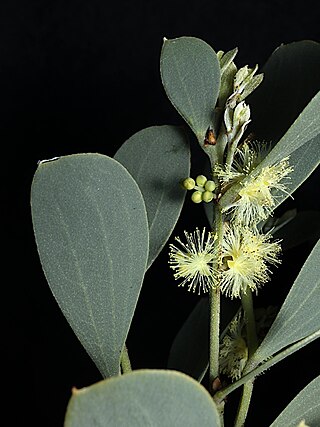
Acacia alpina, commonly known as alpine wattle is a species of flowering plant in the family Fabaceae and is endemic to alpine and subalpine regions of south-eastern continental Australia. It is an erect or spreading shrub or tree with egg-shaped or broadly egg-shaped phyllodes with the narrower end towards the base, flowers arranged in 1 or 2 racemes in the axils of phyllodes, each with cylindrical to oblong, usually pale yellow flowers, and thin-walled, gently curved or coiled pods 30–80 mm (1.2–3.1 in) long.

Acacia acinacea, commonly known as gold dust wattle, wreath wattle or round-leaf wattle. is a species of flowering plant in the family Fabaceae and is endemic to south-eastern continental Australia. It is a bushy or straggling shrub with asymmetric, narrowly oblong to broadly egg-shaped phyllodes with the narrower end towards the base, flowers arranged in a spherical heads 4.0–4.5 mm (0.16–0.18 in) in diameter with 8 to 20 flowers, and a spirally coiled to twisted pods up to 3.0–4.5 mm (0.12–0.18 in) long.

Acacia alata, commonly known as winged wattle, is a species of flowering plant in the family Fabaceae and is endemic to the south-west of Western Australia. It is a much-branched shrub, its phyllodes continuous with the branches and arranged on either side of them, flowers arranged in racemes of 2 spherical heads of white to golden-yellow flowers, and flat, curved, crusty pods 20–80 mm (0.79–3.15 in) long.

Acacia brunioides, commonly known as brown wattle is a species of flowering plant in the family Fabaceae and is endemic to eastern Australia. It is an erect or spreading shrub with more or less cylindrical phyllodes, inflorescenses arranged singly in leaf axils, each with 20 to 27 more or less white to bright yellow flowers, and straight, papery to leathery pods up to 15–60 mm (0.59–2.36 in) long.

Acacia prominens is a shrub or tree in the genus Acacia native to New South Wales, Australia.

Acacia hakeoides, known colloquially as hakea wattle, hakea-leaved wattle or western black wattle, is a species of flowering plant endemic to southern Australia. It is a bushy shrub or tree with lance-shaped to linear phyllodes, racemes of bright golden-yellow flowers and more or less leathery to leathery to hard and brittle pods. It can be found growing in sandy soils in semiarid and Eucalyptus woodland in the region.

Acacia aculeiformis is a species of flowering plant in the family Fabaceae and is endemic to the south-west of Western Australia. It is prostrate, scrambling, mat-forming shrub with asymmetrical elliptic to narrowly elliptic phyllodes, and spherical heads of light to medium golden-yellow or yellowish-red flowers.
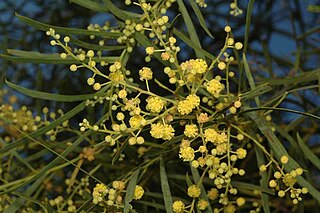
Acacia aestivalis is a species of flowering plant in the family Fabaceae and is endemic to the south-west of Western Australia. It is a bushy shrub or tree with linear to narrowly lance-shaped phyllodes, the narrower end towards the base, racemes of 5 to 11 spherical heads of golden-yellow flowers, and glabrous, papery to thinly leathery pods.

Acacia amblygona, commonly known as fan wattle or fan leaf wattle, is a species of flowering plant in the family Fabaceae and is endemic to continental Australia. It is a sprawling, sometimes prostrate shrub with sharply-pointed, lance-shaped, tapering phyllodes, golden-yellow flowers arranged in a spherical head of 10 to 18 in the axils of phyllodes, and curved, coiled or twisted pods up to 70 mm (2.8 in) long.

Acacia ampliceps, commonly known as salt wattle or spring wattle, is a species of flowering plant in the family Fabaceae and is endemic to the north-west of Australia. It is a large, bushy shrub or small tree with often pendulous branches, pendulous, linear to lance-shaped phyllodes, white to cream-coloured flowers arranged in spherical heads, and pods up to 115 mm (4.5 in) long.

Acacia crassiuscula is a shrub belonging to the genus Acacia and the subgenus Phyllodineae found along the south coast of Western Australia.

Acacia adenogonia is a species of flowering plant in the family Fabaceae and is endemic to northern Western Australia. It is a prickly, erect to sprawling shrub with cylindrical branchlets, egg-shaped to lance-shaped phyllodes, flowers arranged in spherical heads of golden yellow flowers, and thin leathery pods that are constricted between the seeds.
Acacia amyctica is a species of flowering plant in the family Fabaceae and is endemic to the south-west of Western Australia. It is an erect, bushy shrub with ascending to erect, narrowly lance-shaped, sharply-pointed phyllodes with the narrower end towards the base, spherical heads of 18 to 25 golden flowers, and linear to strongly curved pods.
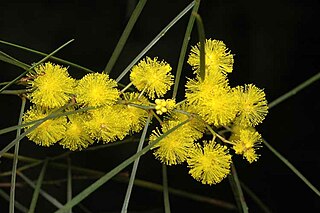
Acacia adunca, commonly known as Wallangarra wattle or cascade wattle, is a species of flowering plant in the family Fabaceae and is endemic to eastern Australia. It is an erect, bushy shrub or tree with narrowly linear phyllodes, racemes of spherical bright golden flowers, and leathery pods.

Acacia aculeatissima, commonly known as thin-leaf wattle or snake wattle, is a species of flowering plant in the family Fabaceae and is endemic to south-eastern continental Australia. It is usually a prostrate shrub with sharply pointed, needle-shaped phyllodes, flowers arranged in up to 3 more or less spherical heads of 15 to 25 flowers, and linear, papery pods up to 60 mm (2.4 in) long.
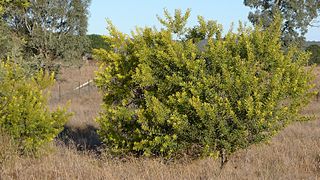
Acacia rubida, commonly known as red stem wattle, red stemmed wattle or red leaved wattle, is a shrub belonging to the genus Acacia and the subgenus Phyllodineae that is native to parts of eastern Australia.

Acacia alcockii, also known as Alcock's wattle, is a species of flowering plant in the family Fabaceae and is endemic to South Australia. It is a bushy shrub with narrowly elliptic to lance-shaped phyllodes with the narrower end towards the base, and racemes of 5 to 11 spherical heads of pale yellow flowers, and oblong pods.
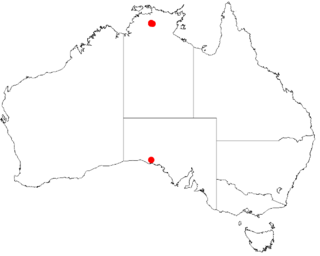
Acacia amanda is a species of flowering plant in the family Fabaceae and is endemic to a very restricted part of the Northern Territory. It is an erect shrub with narrowly elliptic or elliptic, leathery phyllodes, flowers arranged spherical heads of golden yellow flowers usually arranged in a raceme, and narrowly oblong pods 42–110 mm (1.7–4.3 in) long.

Acacia ammophila is a species of flowering plant in the family Fabaceae and is endemic to southern inland Queensland. It has linear phyllodes, flowers arranged in racemes or 2 to 4 spherical heads of 25 to 40 golden yellow flowers, and a pod up to 200 mm (7.9 in) long.





















